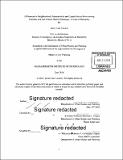| dc.contributor.advisor | Mariana C. Arcaya. | en_US |
| dc.contributor.author | Leal Navarro, Javier | en_US |
| dc.contributor.other | Massachusetts Institute of Technology. Department of Urban Studies and Planning. | en_US |
| dc.coverage.spatial | n-us-ca | en_US |
| dc.date.accessioned | 2016-10-25T19:52:07Z | |
| dc.date.available | 2016-10-25T19:52:07Z | |
| dc.date.copyright | 2016 | en_US |
| dc.date.issued | 2016 | en_US |
| dc.identifier.uri | http://hdl.handle.net/1721.1/105063 | |
| dc.description | Thesis: M.C.P., Massachusetts Institute of Technology, Department of Urban Studies and Planning, 2016. | en_US |
| dc.description | Cataloged from PDF version of thesis. | en_US |
| dc.description | Includes bibliographical references (pages 63-66). | en_US |
| dc.description.abstract | This study positions health as a risk factor for neighborhood selection into poor neighborhoods, and overviews the possible mechanisms that constrain sick people from living in low poverty neighborhoods. Most of the literature on health and place focuses on the unidirectional relationship from place to health, supporting the argument that one's environment affects one's health. However, there is limited research on the causal direction of this association. I compare a group of households with a child with Cerebral Palsy to a group of households that do not have children with special health care needs. I developed a cross sectional analysis, using survey data, geospatial analyses, and a series of statistical tests to compare differences between the two groups. I complemented this research with 16 in-person interviews to get additional information about their environment and daily routine experiences. I find that families with a sick child live in poorer neighborhoods overall. Possible pathways that explain the reason why sick households might live in relatively poorer neighborhoods in comparison to the non-sick households are lower economic productivity, relatively worse mental health, and lack of time due to special care-giving needs and distant living locations. All pathways might potentially operate in conjunction to negatively impact the material, social, psychological, and time resources needed in order to improve neighborhood choice. The results suggest that health places families at peril by decreasing their ability to live in better neighborhoods and increasing their exposure to stressors that could potentially reinforce their poor health. | en_US |
| dc.description.statementofresponsibility | by Javier Leal Navarro. | en_US |
| dc.format.extent | 97 pages | en_US |
| dc.language.iso | eng | en_US |
| dc.publisher | Massachusetts Institute of Technology | en_US |
| dc.rights | M.I.T. theses are protected by copyright. They may be viewed from this source for any purpose, but reproduction or distribution in any format is prohibited without written permission. See provided URL for inquiries about permission. | en_US |
| dc.rights.uri | http://dspace.mit.edu/handle/1721.1/7582 | en_US |
| dc.subject | Urban Studies and Planning. | en_US |
| dc.title | Differences in neighborhood characteristics and capabilities to move among families with and without health challenges : a case of Monterrey | en_US |
| dc.type | Thesis | en_US |
| dc.description.degree | M.C.P. | en_US |
| dc.contributor.department | Massachusetts Institute of Technology. Department of Urban Studies and Planning | |
| dc.identifier.oclc | 959833103 | en_US |
